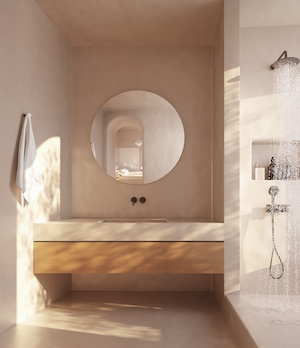
QUESTION
Tumbled limestone tiles, installed around 20 years ago by others on two shower floors, are now degraded so that the surfaces of the tiles are not smooth. Owner wants new tiles. If the substrate has no issues, can we skim coat the surface of the tiles with mortar, add a new underlayment, move drain cover up to new surface level or replace it, and then install new tile over the existing? Or, do we need to remove mud bed substrate under existing tile to the joists or subfloor, then install new underlayment with membrane, new drain cover, and install new tiles?
ANSWER
This is a great question. I’m glad you asked, as there are some very important things to consider.
For background – industry published information related to this topic is found in:
- The 2022 Edition of the TCNA Handbook includes two methods for Shower Receptor Renovation – these are methods TR418 and TR420 on pages 264-265.
- The 2022/2023 Edition of the NTCA Reference Manual has two sections discussing Tile Over Other Surfaces in Chapter 11 – Precautions. Please read through these sections on pages 290-291 for general information.
Both methods TR418 and TR420 are recommended for use where the old shower pan has failed and requires removal of the existing shower receptor and pan.
If you choose to tile over the existing system, you will be accepting and relying on the performance of the old system that was installed by someone else and in use for 20 years. With any tile-over-tile installation, it is recommended to core into the existing tile and substrate to get a good understanding of how the existing tile and its substrate (mud shower pan in this case) was installed and how well it is actually performing. Without doing this, it is just a guess as to how the old system was installed or is holding up.
When installing over an existing mortar bed with a clamping ring drain and weep hole system, you will be relying on the performance of the sloped fill, liner, corner folds, weep holes, attachment to the drain/waste/vent system, etc.
As you noted, the limestone is worn, which is to be expected. Limestone can be very soft and porous. This sometimes makes it a questionable choice for installation in a wet area like a shower. If you install directly on top of the existing limestone on this water-in/water-out system, you will be relying on the ability of the water to weep through the limestone, through the existing mud bed, to the liner and down its pitch on top of the sloped fill to the weep holes and out the drain/waste/vent system. That’s an extra layer for the water to get through.
If a new waterproofing layer is added on top of the limestone or existing mud bed you would have to attach it to the existing clamping ring drain system or add a bonding flange drain that is designed to adapt to the existing clamping ring drain. You will still have to consider how to attach the new topical waterproofing to where it meets the wall. This could be tricky with a liner system. A topical waterproofing layer could trap moisture in the system between the top of the existing liner and the bottom of the new waterproofing layer.
I suggest sticking with the recommendations in TCNA Handbook Methods TR418 and TR420.
Shower pan system or membrane manufacturers may have additional products and installation instructions they recommend.
– Mark Heinlein, NTCA Training Director
RESPONSE
Thank you for the specific information in the manuals, Mark. You’ve raised some good points. It makes sense to follow TR418 and TR420 in the TCNA Handbook. I’ll read these methods as well as Chapter 11 of the 2022-23 NTCA Reference Manual.







